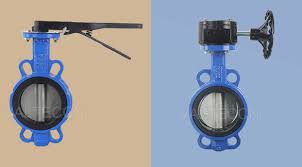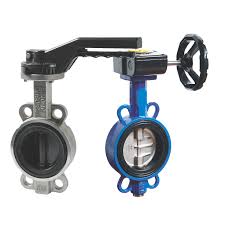Gear Operated Butterfly Valve

The Application of Gear Operated Butterfly Valve
Introducing the Gear Operated Butterfly Valve, a robust solution for precise fluid control in industrial applications. Cameron, a trusted leader in the industry, offers top-tier quality and reliability.
Designed for optimal performance, this valve complements renowned brands like Eclipse butterfly valve, Fisher butterfly valves, and Flowseal butterfly valve. With Cameron brass ball valve standards and butterfly valve seat technology, coupled with materials like A350 LF2, Cameron ensures durability.
Ideal for various industrial settings, this valve’s versatility and reliability make it a preferred choice for fluid control. Available in a range of sizes to suit specific requirements, Cameron’s butterfly valve size range ensures optimal performance in diverse applications.
How does a Butterfly Valve Gear Operated work?
A gear-operated butterfly valve operates by getting power from the valve operator. The operator applies force on the handwheel to operate the valve. The handwheel is connected to a gear system via a short shaft. To open the valve, the operator turns the handwheel for a quarter turn in anticlockwise. This makes the torque (or rotary force) applied on the handwheel to be transmitted to the valve disc via the stem. As such, the disc makes a quarter turn angle where it becomes oriented parallel to the fluid flow. In this state of the disc, the fluid flows through the valve unobstructed. To close the fluid flow, the valve operator turns the handwheel in the clockwise direction. This forces the disc to make a 90o degree turn and become perpendicular to the fluid flow. In this state, the disc blocks fluid flow from crossing the valve. Gear-operated butterfly valve manufacturers make these valves for use even in throttling applications. However, the use of these valves in such throttling applications is recommended where the pressure drop is low. When the valve needs to be used in throttling applications, the valve operator turns the handwheel slightly for an angle of less 90o degrees depending on the amount of fluid flow required.
Features of Gear Operated Butterfly Valve
- The operator flange conforms to ISO 5211. Designed to work with manual, pneumatic, or electric actuators.
- The rubber seat is non-collapsible, stretch-resistant, and blowout-proof.
- The precision machined disc ensures low operating torque and effective sealing up to 200 psi. The hydro-dynamically designed disc allows for high-capacity flow.
- The one-piece shaft design ensures dependability and positive disc positioning.
- Valves are epoxy coated and incorporate “zerk” style grease fittings for easy lubrication on the neck & gearbox (if applicable).
What is a Gear Operated Butterfly Valve?
ZECO gear-operated butterfly valve is named after the way the gear operated. ZECO pays attention to every detail of the valve. Every valve is inspected and installed strictly to ensure that the valve is in good condition and ready for operation. However, the valve in the control of raw materials or the subsequent production and processing, inspectors only each link control well according to the requirements of technical engineer testing, pressure test, have answers to the very end to prove its performance. Moreover, even if the trial is successful, should check the valve stem seal and packing, and the packing should be in the initial position. Valve is a special product with certain movement rules and friction rules. In order to achieve satisfactory performance, some parts of the machine should be carefully protected. At the right pressure, medium, and temperature, the continuous service life of the valve will not be less than 6 years.
The Parameter of Gear Operated Butterfly Valve
- Valve Type: Gear Operated Butterfly Valve.
- Size: Available in various sizes to suit different pipeline requirements.
- Pressure Rating: ANSI 150, ANSI 300, etc., suitable for different pressure levels.
- Temperature Range: Standard operating temperature from -20°C to 200°C (-4°F to 392°F).
- Body Material: Typically constructed from materials such as stainless steel, carbon steel, or ductile iron.
- Disc Material: Made of corrosion-resistant materials like stainless steel or ductile iron.
- Seat Material: Utilizes resilient materials like EPDM or PTFE for reliable sealing.
- Actuation Type: Gear-operated mechanism provides manual control over the valve.
- End Connection: Available with various end connections such as wafer, lug, or flanged.
- Leakage Rate: Engineered to meet industry standards for minimal leakage.
- Fire Safety: May feature fireproof seat design and metal-to-metal seals.
- Compliance: Complies with industry standards such as API, ANSI, and ISO.
- Maintenance: Designed for easy maintenance with replaceable seats and seals.
- Accessories: Compatible with various accessories like position indicators and limit switches for enhanced functionality.

The Operation Theory of Gear Operated Butterfly Valve
The operation theory of a Gear Operated Butterfly Valve involves manual control over fluid flow. Similar to Keystone GRL butterfly valve, LKB-F butterfly valve, and Milwaukee butterfly valves, it utilizes a gear-operated mechanism to open and close the valve. This manual operation allows for precise adjustments and reliable flow control in various industrial applications.
The Parameters Table of Gear Operated Butterfly Valve
| Parameter | Description |
|---|---|
| Valve Type | Gear Operated Butterfly Valve |
| Size | Various sizes available |
| Pressure Rating | ANSI 150, ANSI 300, etc. |
| Temperature Range | -20°C to 200°C (-4°F to 392°F) |
| Body Material | Stainless steel, carbon steel, ductile iron |
| Disc Material | Stainless steel, ductile iron, aluminum |
| Seat Material | EPDM, PTFE, metal-to-metal |
| Actuation Type | Gear-operated mechanism |
| End Connection | Wafer, lug, flanged |
| Leakage Rate | Meets or exceeds industry standards |
| Fire Safety | Fireproof seat design, metal-to-metal seals |
| Compliance | API, ANSI, ISO |
| Maintenance | Replaceable seats and seals for easy upkeep |
| Accessories | Compatible with various position indicators and limit switches |
Relevant Information about Gear Operated Butterfly Valve
- Rotor: The rotor is the part of the valve that rotates to control the flow of fluid.
- Stator: The stator is the stationary part of the valve that surrounds the rotor and provides support.
- Universal Joint: The universal joint connects the gear mechanism to the valve shaft, allowing for rotational movement.
- Shaft Seal: The shaft seal prevents leakage along the valve shaft, ensuring the integrity of the valve.
- Driving System: The driving system includes the gear mechanism and associated components that allow for manual control of the valve’s operation.

